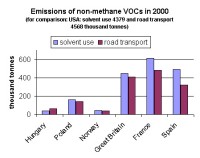|
|
 |
|
|
|
 |
| |
|
|
 |
Urban Climate
Read more |
Industry and other branches of economy
Energy production and transportation are the most common sources of air pollution and so they are discussed in another section of the encyclopedia (this unit - Fuel combustion). Other branches of economy, especially industry, e.g. metallurgy, construction materials' industry, chemical factories, refineries and paper mills also play a significant role. Agriculture and municipal economy are additional sources of air pollution. |
|
|
|
|
 |
 |
 |
|
1. Steel works
Source: www.freefoto.com
|
|
 |
Metallurgy is the main industrial source of air pollution. It delivers first of all sulphur dioxide (SO2) and very toxic dust, containing various heavy metals. Moreover, steel-works emit lots of carbon monoxide (CO), and aluminium works - lots of fluorine, which is very harmful for living organisms. |
Factories producing building materials emit large amounts of dust to the atmosphere. Cement plants deliver chemically neutral dust but its quantity is usually disturbing not only for the neighbourhood area. The dust may be transported by the wind to large distances and effect areas placed far away from the emission source. Other types of factories from this sector are stone-pits, glass-works, aggregates-processing plants, ceramics plants and limestone quarries, but all of them have only local impact on air pollution.
|
 |
 |
 |
|
2. Lime works
Source: www.freefoto.com
|
|
 |
 |
|
3. Chemical works
Source: www.freefoto.com
|
|
 |
Chemical industry emits wide variety of pollutants. It results mainly from the production of nitrolime, phosphates, petrol, car oils and greases, and artificial fibres. During the production of the most popular nitrolime, the so-called Norway saltpetre, lots of dust containing saltpetre, urea, ammonia (NH3) and nitric oxides (NOx) are emitted into the air. For the production of phosphates, the sulphuric acid (H2SO4) is necessary, and its production makes a significant source of sulphur emission to the atmosphere. Phosphates' production causes also emissions of fluorine and dust. |
Refineries, producing petrol, car oils and greases, emit mainly SO2 and hydrocarbons, but also smaller amounts of other very toxic substances: ammonia, acetone, benzene, phenol, xylene, toluene, lead.
|
 |
 |
 |
|
4. Oil rafinery
Source: www.freefoto.com
|
|
 |
 |
|
5. Main ANTHROPOGENIC sources of air pollution. Please note that in the global scale, the main source of CO is biomass burning.
If you wish to see what kinds of air pollution is delivered by particular sources - click on the image (56 K)
Authors: Pawel Jezioro, Anita Bokwa
|
|
 |
The basic raw materials in the production of artificial fibres are carbon disulphide and hydrogen sulphide (H2S). Both those substances are also main emitted air pollution. Apart from being highly toxic they are also characterised by a very unpleasant smell. |
From other industry branches generating air pollution, worth mentioning are: 1) paper-mills, emitting many malodorous substances, and 2) plants producing machines and using the process of plating and varnishing; they emit heavy metals and resolvents.
|
 |
 |
 |
|
6. Chipboard factory
Source: www.freefoto.com
|
|
 |
 |
|
7. Crop spraying
Source: www.freefoto.com
|
|
 |
Agriculture is also a source of air pollution. Artificial fertilizers and pesticides are often spread over the fields from the air-planes, which causes air pollution with solid particles of very little diameter. Another massive process is burning the garbage, as it usually has a significant caloric value and may be used as a source of energy. It is estimated that the amount of air pollution emitted by all garbage burning plants is equal to the amount of air pollution generated during the vegetation fires.The soil surface erosion can generate large amounts of the very little particulates of the diameter up to 2.5 Ám (the so-called PM 2.5). They can be transported with wind to large distances.
|
Volatile Organic Compounds (VOCs) are chemical substances built mainly of hydrogen and carbon atoms. They are also called hydrocarbons. The most common VOC is methane but usually it is not included into the sum of VOCs; it is rather mentioned as a greenhouse gas. Other hydrocarbons are e.g. benzen, terpene, isoprene and benzopyrene. They are produced by both the natural and anthropogenic sources. Total emission from natural sources is much bigger than from anthropogenic ones, but in urbanised areas it is the anthropogenic one that prevails. The main sources are cars' exhaust gases and usage of resolvents in industry. In 1995, 159,634 thousand tonnes of VOCs (excluding methane) was released globally to the atmosphere due to incomplete combustion of gasoline by motor vehicles, due to usage of solvents in a variety of industrial and commercial processes, and due to chemical manufacturing and petroleum refining. About 23% from the global number (36,782 thousand tonnes) comes from Europe. VOCs contribute significantly to the formation of photochemical smog and additionally some of them are carcinogenic.
|
 |
 |
 |
|
8. Emissions of non-methane VOCs in 2000 in chosen European countries (for comparison: USA: solvent use: 4379 Gg, road transport: 4568 Gg)
Please click to see enlarged chart! (48 K)
data source: http://webdab.emep.int, UNECE/EMEP emission database
|
|
|
About this page:
Authors: Pawel Jezioro, Anita Bokwa - Jagiellonian University - Cracow / Poland
1. Scientific reviewer: Prof. Barbara Obrebska-Starkel - Jagiellonian University - Cracow / Poland - 2003-06-20
2. Scientific reviewer: Dr. Marek Nowosad - Maria Curie-Sklodowska University - Lublin / Poland - 2003-06-16
3. Scientific reviewer: Dr. Josef Brechler, Assoc. Prof. - Charles University - Prague / Czech Republic - 2003-10-03
educational reviewing:
last update: 2004-12-17
|
|
 |
|









